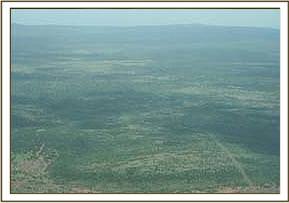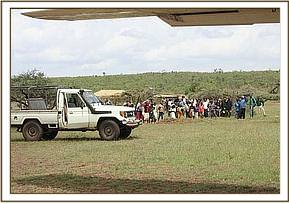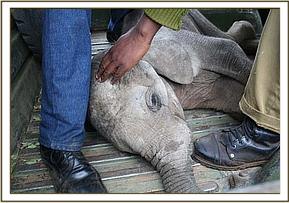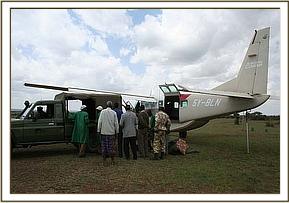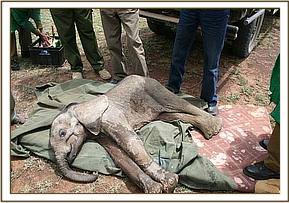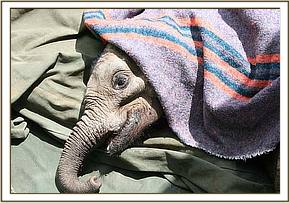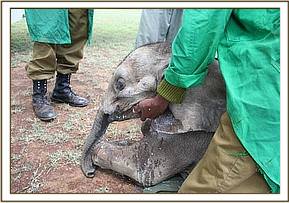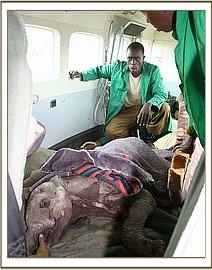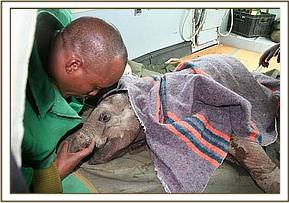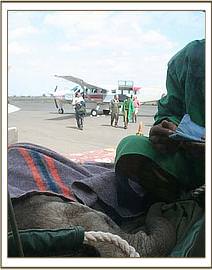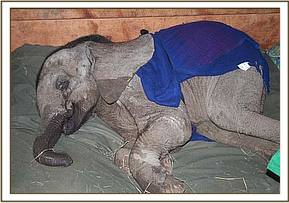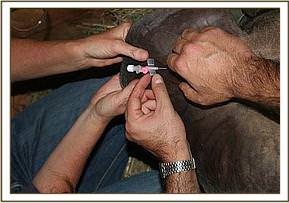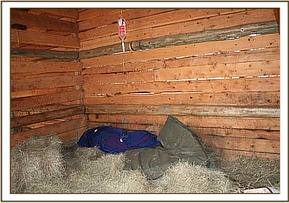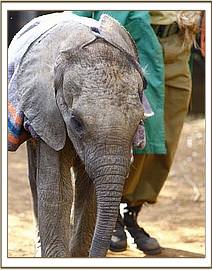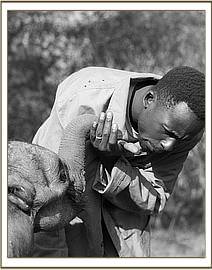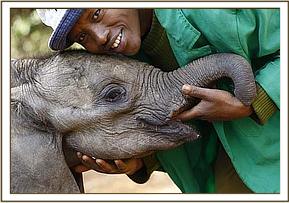









Now living wild, where she is raising her own family
Current age
17 years old
Gender
Female
Rescued date
18 August 2008
Rescue location
Samburu, Maralal National Park
Date of birth (estimate)
25 May 2008
Reason orphaned
Poaching
Age at rescue
2 months old (approx)
Current location
Living Wild
She lay limp on the mattress; little life left in her eyes, and totally dehydrated and emaciated, her skin literally hanging from her bones, her cheeks sunken and gaunt. This baby had obviously been without her mother of as long as five days, an inordinate amount of time for a milk dependent calf this young. One could only imagine what a nightmare she had endured before finding the comfort and security of the Samburu manyatta and her rescuers, Kanyina Lentrangoi, Kopolesha Lemunar, Chamke Lopiala.
This orphaned calf walked into a manyatta close to Maralal at 9.00am on the morning of the 18th August, causing quite a stir. She was desperately trying to suck up liquid from any muddy puddle directly into her mouth, still too young to be able to effectively use her trunk, and she immediately followed anyone who came close, desperate for protection, food and comfort.
The elders of the manyatta discussed the best course of action for their surprise visitor that morning, and decided to walk the calf to the closest Kenya Wildlife Service ranger station in Suguta Mar Mar. This was time consuming, and the exercise generated enormous interest from the neighboring community, but the calf followed the men, despite being very weak. Once at the station she was given water by a KWS ranger called Daniel, a Sheldrick Wildlife Trust De-Snaring Team member from the area, who was fortunately on leave at the time. Daniel tended to the elephant, and was able to ensure that she was not given cows milk, which would have caused grave stomach problems, for infant elephants cannot tolerate the fat of cows milk. He immediately alerted the Sheldrick Wildlife Trust headquarters in Nairobi, but it was evening, with no time left for a rescue to be mobilized that day.
The calf was kept overnight at the KWS station, and the next day the rescue team of Sheldrick Wildlife Trust elephant Keepers and an aircraft were mobilised, landing at the Mugie Ranch Airstrip, the closest airstrip to the town of Suguta Mar Mar. The Kenya Wildlife Service warden from Maralal kindly arranged for a vehicle to be sent to transport the calf from the Ranger station directly to the airstrip, a journey of one hour, where they were waiting when the plane landed. Our Keepers immediately gave her rehydration and milk, but in her weakened state she took little of both. It was not necessary to strap her down for the flight, her legs bound gently; she just lay immobile for the whole journey.
In the meantime, our Vet, Sanjay, had been alerted, and was on standby at the Nursery to immediately place her on a drip. Once this was done she slowly began to brighten up. We continued with the drip on and off for a 24 hour period and this undoubtedly saved her life. She began taking her milk, and orally consuming glucose water and rehydration salts. We all watched in amazement as this little calf, who we named Suguta, slowly came back to life. An ongoing and slow process, but progress is evident with each passing day. She is truly our miracle baby, and owes her life to many who grappled with enormous odds in order to save her. It is within the story of Suguta that one sees the worst and the best of man. The worst being those from the Pokot tribe who killed her mother, (a number of poaching incidences have recently been reported from this area) and the best being her rescuers, who surmounted numerous obstacles in order to bring her to safety, so that she could have a second chance at life.
She lay limp on the mattress; little life left in her eyes, and totally dehydrated and emaciated, her skin literally hanging from her bones, her cheeks sunken and gaunt. This baby had obviously been without her mother of as long as five days, an inordinate amount of time for a milk dependent calf this young. One could only imagine what a nightmare she had endured before finding the comfort and security of the Samburu manyatta and her rescuers, Kanyina Lentrangoi, Kopolesha Lemunar, Chamke Lopiala.
This orphaned calf walked into a manyatta close to Maralal at 9.00am on the morning of the 18th August, causing quite a stir. She was desperately trying to suck up liquid from any muddy puddle directly into her mouth, still too young to be able to effectively use her trunk, and she immediately followed anyone who came close, desperate for protection, food and comfort.
The elders of the manyatta discussed the best course of action for their surprise visitor that morning, and decided to walk the calf to the closest Kenya Wildlife Service ranger station in Suguta Mar Mar. This was time consuming, and the exercise generated enormous interest from the neighboring community, but the calf followed the men, despite being very weak. Once at the station she was given water by a KWS ranger called Daniel, a Sheldrick Wildlife Trust De-Snaring Team member from the area, who was fortunately on leave at the time. Daniel tended to the elephant, and was able to ensure that she was not given cows milk, which would have caused grave stomach problems, for infant elephants cannot tolerate the fat of cows milk. He immediately alerted the Sheldrick Wildlife Trust headquarters in Nairobi, but it was evening, with no time left for a rescue to be mobilized that day.

View diary updates from across all our orphan units as written by the Keepers

17 years ago, a tiny calf wandered into a Samburu village, desperately seeking help. Today, that same elephant proudly strode up to our Ithumba stockades, introducing us to her brand new baby boy. Suguta has become a mum!
Suguta counts as one of our miracle babies. Orphaned through poaching and rescued as an infant, she was a hard-one success. To meet her first son just hours after he was born was a privilege indeed. Read more
By adopting, you play a vital role in the life of an orphaned elephant, rhino, or giraffe — helping us provide the round-the-clock, loving attention each one needs and deserves over many years, so they can ultimately reclaim their place in the wild.
Your adoption supports the 100+ orphans in our care at any given time, covering the cost of milk and food supplies, Keepers' salaries, veterinary treatment, and other essentials.

Celebrate your adoption with a personalised certificate, ready for you or your lucky gift recipient to print and display!

Each month, we send a detailed update about our Orphans’ Project direct to your email inbox, featuring photos, stories, and special highlights.

From the latest Keepers’ Diaries to a downloadable image gallery and more, adopters have exclusive access to our content library.
